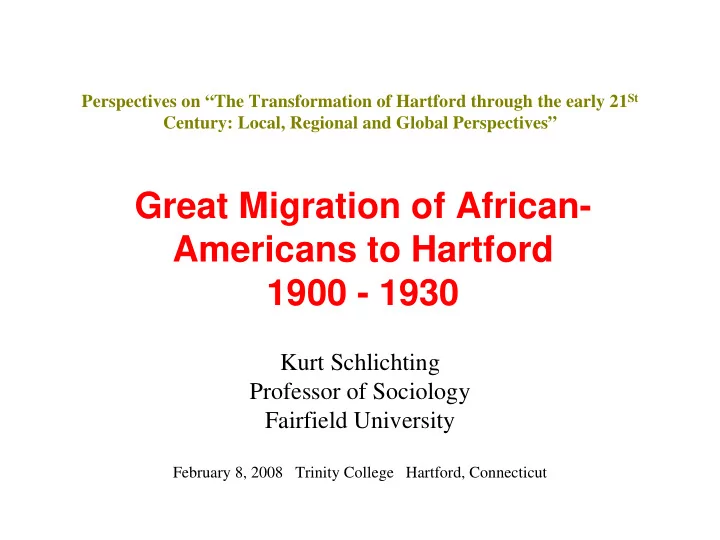

Perspectives on “The Transformation of Hartford through the early 21 St Century: Local, Regional and Global Perspectives” Great Migration of African- Americans to Hartford 1900 - 1930 Kurt Schlichting Professor of Sociology Fairfield University February 8, 2008 Trinity College Hartford, Connecticut
I. Introduction • Innovative use of GIS to do historical sociology • When analyzing Great Migration focus on inner-city - post WWII • Less well understood is the historical process of migration Ex. At beginning of Great Migration (1900 – 1930) where African-American migrants residentially isolated? When did distinctly African-American neighborhoods emerge? Within the African-American population which subgroups had high/ low socio-economic status and resided in ghetto areas?
II. GIS Methodology • Build digitized street maps of Hartford, CT Resources: contemporary digitized street map City Directory – 1900, 1910, 1920, 1930 Plat maps Insurance maps • Geocode: create address range file for each street segment – verify address ranges with City Directories
Step 1 - Remove contemporary streets Restore 1920 streets Step 2 – adjust addresses ranges on street segments to 1910 & 1920 address ranges
III. African-American Population – 1900 - 1930 • 1900, 1910, 1920, 1930 Census – National Archive • Ancestry.com • Record & code data for all African Americans 1900 N = 1,878 1910 N = 1,812 1920 N = 4,248 1930 N = 6,453 • Coding scheme: IPUMS – University of Minnesota • Add 1910 & 1920 Registration & Voting Data - males 21+ Source: City of Hartford archives
IV.Residential Patterns – GIS Analysis • Use 1910/ 1920 digitized map and geocoded address records for African-American population • Analyze residential patterns at individual level & by spatial units. • African-Americans concentrated in Wards near city center (Wards: 2, 3, & 5). • African-Americans living in the affluent Wards 9 & 10 are servants living in White households. • GIS analysis allows for examination of “clustering” of population by neighborhood & street and by sub-groups within African – American population.
V. Change in Residential Patterns from1910 to 1920 • Dramatic increase in population - New migrants from Georgia • Georgians recruited to work on tobacco farms – move to Hartford • “Chain migration” from Americus Georgia (Master Thesis: “They Must Make Good: The Migration of African Americans to CT During WWI) • National Urban League: “The Negro Population of Hartford” C. Johnson – Dept. of Research, 1921 150 pages • Define 6 African-American neighborhoods
Urban League Districts • 3,4,5 “oldest…most deteriorated – crude Southern Laborers…ne’er-do-wells…Little attention…to home life…least advanced…criminal…not…uniformly bad…occasional blocks…striking contrast ” • 1,2 “distinct improvement in their general aspect…more home owners…new Negro churches…larger proportion of modernly equipped homes” • Create digital map – add to GIS • Code all African-Americans by Urban League Districts
VI. GIS Analysis of Residential clustering – major subgroups 1920: • Connecticut, Georgians, Virginians • Use radius program/ proximity analysis: – 1. draw radius around each individual ( .1 mile) – 2. count individuals within radius by subgroup – 3. determine average proportion of residents, within radius around each individual, who are members of same subgroup Analysis limited to heads of households, boarders, lodgers & roomers N = 1570
Residential Clustering Analysis Average % % of subgroup in population subgroup within .1 mile radius 23.2 % 13.7 % Connecticut Connecticut 27.0 % 16.5 % Virginians Virginians 56.9 % 37.0 % Georgians Georgians
Residential Clustering - Georgians • Georgians most recently arrived African- Americans • Clustered – live in close proximity to other Georgians • 58.1% of Georgians live in Urban League Districts 4, 5, 6 • Similar pattern to “chain” migration among European immigrants
VIII. Conclusions • Significant change in African-American population in Hartford from 1900 to 1930 • Increase in population includes many migrants from Georgia • Overall residential segregation. • Within black population – Georgians are spatially clustered, living near other members of subgroup. Live in worst of the 6 defined African-American neighborhoods. • Research illustrates use of GIS for historical study.
Recommend
More recommend